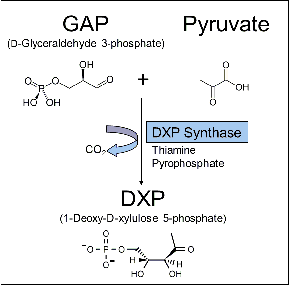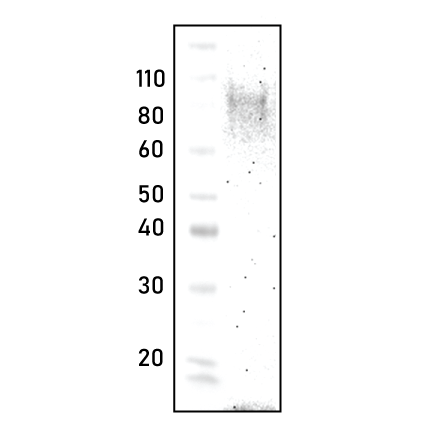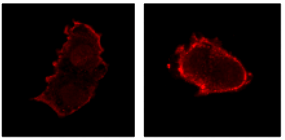In the first step of the methylerythritol phosphate (MEP) pathway for isoprenoid biosynthesis, D-glyceraldehyde 3-phosphate (GAP) and pyruvate undergo a condensation reaction to produce 1-deoxy-D-xylulose 5-phosphate (DXP) by DXP synthase (DXS) in a thiamine diphosphate (or thiamine pyrophosphate) dependent manner.
The MEP pathway is used by most bacteria, including all Gram-negative bacteria, for isoprenoid biosynthesis. Isoprenoids comprise one of the most diverse classes of compounds found in nature. With over 50,000 different isoprenoids identified to dtae, they exhibit a broad range of structural complexity and are involved in a variety of biological functions [2]. Electron transport (quinones), stabilization of cell membranes (hopanoids and sterols), cell wall biosynthesis (dolichols), signal transductions (prenylated proteins), photosynthesis (chlorophylls) and modification of tRNAs are among the processes that involve isoprenoids [3]. Isopentenyl diphosphate (IPP) and dimethylallyl disphosphate (DMAPP) are the precursors for all isoprenoid compounds and two unrelated essential pathways exist in nature for their biosynthesis. These two precursors are produced by either the mevalonate (MVA) or MEP pathway. The MVA pathway is found primarily in eukaryotes, including humans, plant cytosol, Archaea, and some Gram-positive bacteria, while the MEP pathway is utilized by most bacteria and plant cholorplasts. Due to this natural distribution, the MEP pathway represents a promising target for development of novel antibacterial agents and herbicides [4].
Storage
Store product frozen below -20°C. Enzyme will be stable for at least 6 months at -20°C as undiluted stock. Freeze in working aliquots to avoid repeated thawing and freezing
References
1) Bochar, D.A.; Freisen, J.A.; Stauffacher, C.V. and Rodwell, V.W.(1999) in Comprehensive Natural Products Chemistry, (Cane, D. Ed.) Pergamon Press, Oxford, pp. 15-44.
2) Sacchettini, J.C. and Poulter, C.C. (1997) Science, 277(5333), 1788-9.
3) Testa, C.A.; Brown, M.J. (2003) Current Pharmceutical Biotechnology, 4, 248-259.




